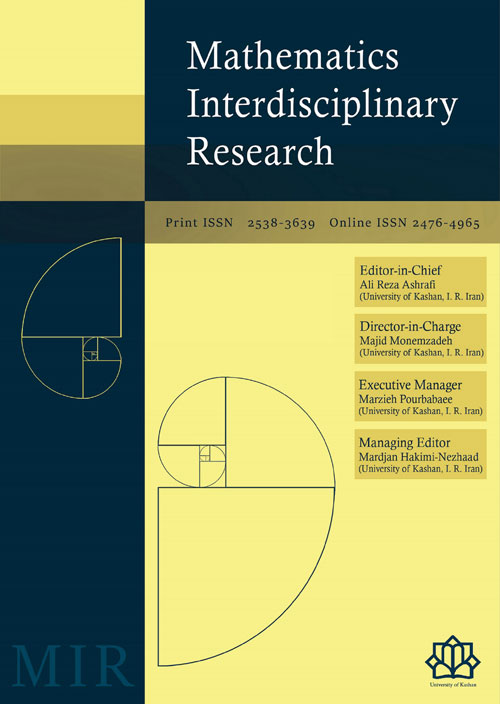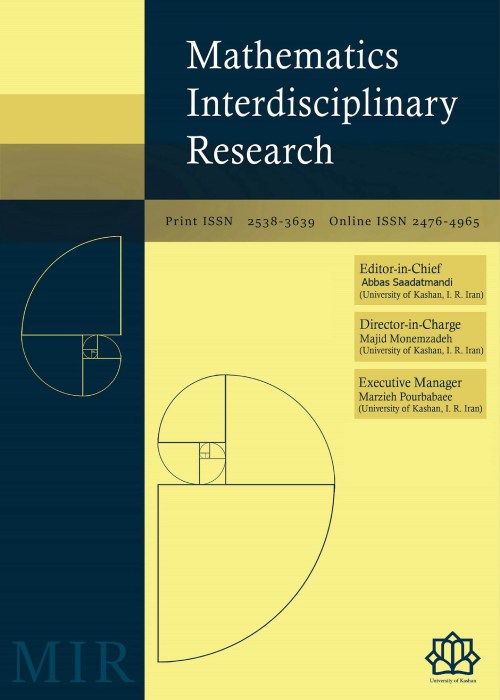فهرست مطالب

Mathematics Interdisciplinary Research
Volume:7 Issue: 2, Spring 2022
- تاریخ انتشار: 1401/07/27
- تعداد عناوین: 6
-
-
Pages 105-129
This article addresses the following biharmonic type of the Kirchhoff-Schrödinger-Maxwell system;∆2 w − (a1 +b1∫RN |∇w| 2 )∆w + ηψw = q(w) in RN,−∆ψ = ηw2 in RN, (bKSM)in which a1 ,b1 and η are fixed positive numbers and q is a continuous real valued function in R. We are going to prove the existence solution for this system via variational methods, delicate cut-off technique and Pohozaev identity.
Keywords: Biharmonic equations, Kirchhoff-Schrödinger-Maxwell, Cut-off function, Pohozaev identity -
Pages 131-138This study contributes to the theory of Riemann-Stieltjes integral. We prove that if all continuous piecewise linear functions are Riemann-Stieltjes integrable with respect to a bounded integrator α : [a,b] → R, then α must be of bounded variation on [a,b]. We also provide some other consequences.Keywords: Cantor’s intersection theorem, Function of bounded variation, Riemann-Stieltjes integral
-
Pages 139-153In this paper, we discuss the properties of reversed aging intensity (RAI) function for discrete random variable and study its nature for some distributions. Further, using this function we characterize some discrete related distributions. The closure properties of the aging classes defined in terms of RAI function are also presented and study its closure properties under different reliability operations, viz., formation of k-out-of-n system. Moreover, we define an ordering, called reversed aging intensity ordering and study its relationship with some usual stochastic orderings. Also a numerical example is given to explain the theoretical results.Keywords: Characterization, k-out-of-n system, Reversed aging intensity, Stochastic orders, Discrete reversed failure rate
-
Pages 155-164For an important nonlinear acoustic model, the (2+1)-dimensional Zabolotskaya–Khokhlov(ZK), a symmetry group and the optimal systems of the symmetry subalgebra have been introduced. Then related symmetry reductions and similarity solutions have been presented via two-stage using of the symmetry group method.Keywords: Zabolotskaya–Khokhlov equation (ZK), Symmetry of differential equations, Reduction of equation, Similarity solution
-
Pages 165-178In this paper, we study several conditions on ordered regular semigroups containing a zero element. In particular, we consider the natural and semigroup order and their connections to the properties of being principally ordered, Dubreil-Jacotin and BZS. We study also the set of biggest inverses in such a semigroup and we characterize subalgebras generated by two comparable idempotents.Keywords: Ordered semigroups, Regular, Naturally ordered, Principally ordered, Strong Dubreil-Jacotin, Semilattice
-
Pages 179-195It has been claimed that Protein-Protein Interaction (PPI) networks are scale free that contain a few hubs with ability to bind multiple proteins. Hubs are classified as party and date hubs. Party hubs generally bind different proteins in specific module simultaneously, while date hubs interact with multiple proteins in different modules at different times and locations. Generally, they have been divided into two classes based on the average Pear- son Correlation Coefficient (avPCC) of expression over all partners or their functions. In this study, we propose a two-step algorithm to classify party and date hubs based on their topological features of PPI network. In the first step, we calculate some topological features for each hub vertex in PPI network. In the second step, we apply an unsupervised learning model to calculate Laplacian score for each feature. The Laplace value for each hub vertex are considered based on Laplacian scores. Finally, the hub vertices are classified into two classes date hubs and party hubs with respect to Laplace values. We evaluate our method on reference hubs based on the avPCC on PPI network. We show that the combination of topological features based on ULPD can improve the performance of each topological feature. Finally, we investigate the performance of our method for human dataset and analyze two types of hubs as drug targets for Covid-19.Keywords: Party hub, Date hub, Topological features, Unsupervised learning model


